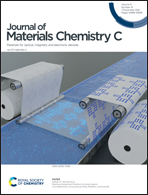Stability enhancement of InP quantum dot/poly(methyl methacrylate) nanocomposites for light-emitting diode applications by grafting thermoresponsive poly(N-isopropylacrylamide)†
Abstract
The low stability of InP-based quantum dots (QDs) under high temperature and humidity is a major obstacle to their practical applications and commercialization. Herein, we report on the stability enhancement of InP QD/poly(methyl methacrylate) (PMMA) nanocomposites against heat and moisture by grafting poly(N-isopropylacrylamide) (PNIPAM) on the QDs. PNIPAM-grafted QDs were prepared via ligand exchange and dispersed in a PMMA solution to fabricate the nanocomposites. For comparison, nanocomposites containing bare QDs and PMMA-grafted QDs were also fabricated, and their optical properties and light-emitting diode (LED) applications were investigated. The quantum efficiency, luminous efficacy, and color-conversion efficiency of the nanocomposites containing polymer-grafted QDs were significantly higher than those of the nanocomposites with bare QDs because of the affinity between the polymeric ligands (PMMA and PNIPAM) and the PMMA matrix. In addition, the stability of the nanocomposites was estimated at 85 °C/85% relative humidity for 30 days. The results indicate that the nanocomposites containing polymer-grafted QDs were more stable against heat and moisture than the nanocomposites containing bare QDs. Furthermore, the nanocomposites containing PNIPAM-grafted QDs exhibited superior stability to that of the nanocomposites containing PMMA-grafted QDs. The excellent stability of the nanocomposites containing PNIPAM-grafted QDs was attributed to the thermoresponsive characteristics of PNIPAM, which effectively hindered the penetration of water molecules to the QD surface, thereby preventing oxidation at a temperature above the lower critical solution temperature.



 Please wait while we load your content...
Please wait while we load your content...